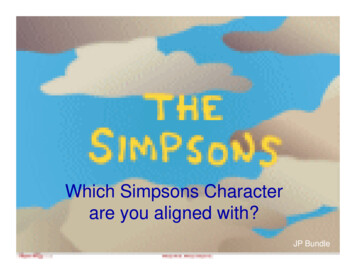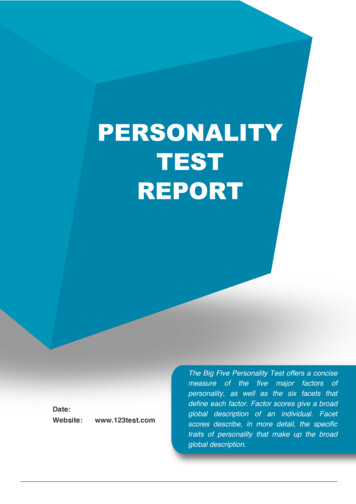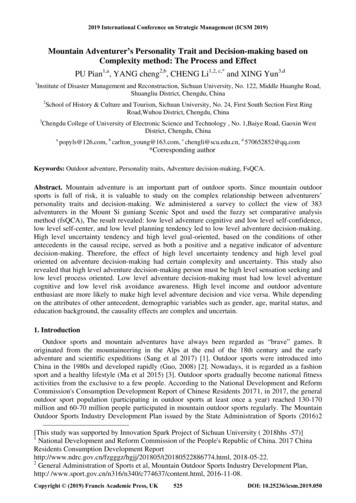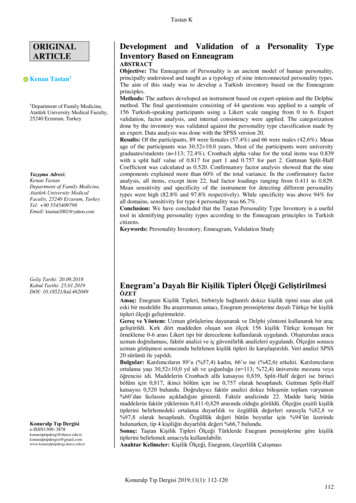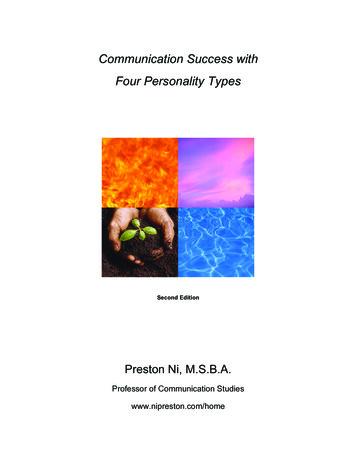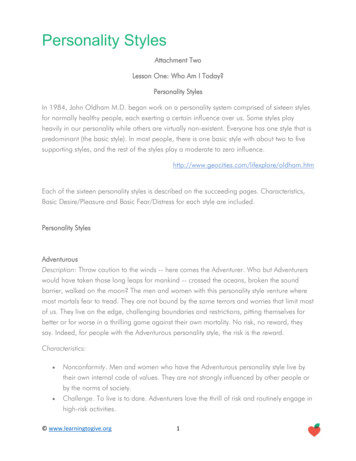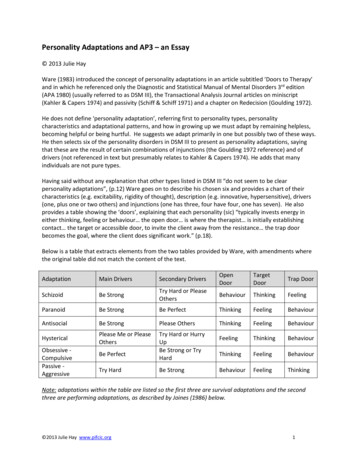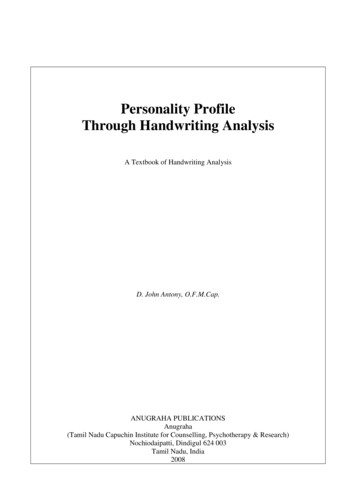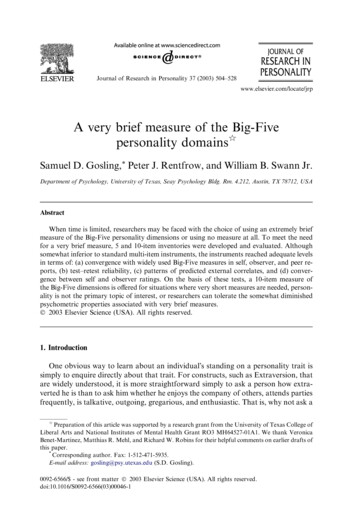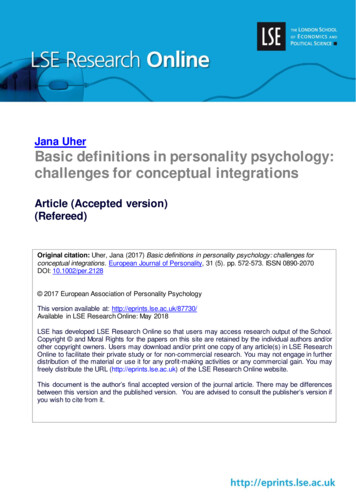
Transcription
Personality Test GuideFree Version
ContentsWhat Are Personality Tests . 3The Veil of Secrecy around Personality Tests . 3Stress and the Personality Test. 4-5How to read the instructions of a personality test . 5-6Popular Personality Test Formats . 6-11Our Personality Test Model . 12-1410 Golden Rules of Personality Testing . 15-16Final Words . 17
PERSONALITY TESTS – WHAT ARE THEY ALL ABOUT?Personality tests are designed to measure a candidate's internal characteristics, such as feelings, attitudes,motives, and so on. This may sound at first like a sophisticated test you cannot prepare for and whose resultsyou are unable to affect, but, the truth is that you can. The essence of these tests is that they supply therespondent with direct questions for which the respondent must provide an answer. Personality tests use theability possessed by all human beings to offer information about their life events and experiences as well astheir otherwise unobserved thoughts and feelings. Because of the personality test's "question-and-answer"format, this type of assessment is known as a "self-report."THE VEIL OF SECRECY AROUND PERSONALITY TESTSThe personality is the most mystifying element of the selection process. When you come to take a preemployment personality test, you are meeting with the unknown. You are placed in front of a computer screenand then flooded with a myriad of questions that seem to have nothing to do with the job you applied for.It makes you wonder how these unrelated questions allow assessors to draw conclusions about whether youfit the job or not. Because people do not know what these tests actually measure, it is natural that someapplicants believe they are inaccurate and others feel that these tests provide some sort of magic that can"see them through."Both attitudes toward personality tests are often a reason for failure. If you approach the test with resistance,cynicism, anger, or fear, you minimize your chances of success.In fact, the personality test is a much more applicant friendly tool than many others, such as the job interviewand group dynamics. It is well-known that the job interview, for example, may be interviewer-biased, whilepersonality tests are fully computerized and your results are 100% in your own hands.IF YOU READ THIS GUIDE CAREFULLY, AND MORE OVER – THE COMPLETE GUIDE ON PERSONALITY TESTPERSONALITY PREPPACK – YOU WILL GAIN ALL THE INFORMATION YOU NEED TO SUCCEED ON A PERSONALITYTEST.3https://www.jobtestprep.com/http
STRESS AND THE PERSONALITY TESTAny type of assessment is a stressful experience. Given the scarcity of knowledge about personality tests, aswell as the ambiguous reputation they have, these assessments are even more stressful then other tests.Moreover, while other tests measure things you have achieved or accomplished--or at least confidently knowabout yourself--personality isn’t something you have built or chosen for yourself. In fact, you are not evennecessarily fully aware of its every aspect. Thus, this experience of others looking into your mind andattempting to reach its deepest corners is definitely not a pleasant one, to put it mildly.Such stress leaves its mark on anybody’s performance, and every effort should be made to minimize its impact.Feelings of stress associated with test-taking can influence your behavior in four ss4.Irritation Behavior4https://www.jobtestprep.com/http
Our complete guide contains explanations about each of the mention above and useful tips on how to dealwith them. The aim of this guide is to supply you with the means you need to be ready and calm before thetest.HOW TO READ THE INSTRUCTIONS OF A PERSONALITY TESTEvery personality test begins with a passage containing legal information and test instructions. Some of theseinstructions are actually misleading, and it is a bad idea to follow them precisely. The most common of themare: Just be yourself. There are no right or wrong answers. Give the first answer that comes to your mind. Nobody is flawless; everyone has made mistakes.Misleading Instruction #1: Just be yourself.The purpose of this instruction, according to the assessors, is to receive the most authentic answers fromcandidates.Let's analyze: what does it really mean to "be yourself"? Our day-to-day behavior is strongly influenced by thesituations we're in. The nature of those situations influences our stress level, which in turn has an impact onour behavior. For example, you can act aggressively in one stressful situation but courteously in another.Which side of your personality do you want to show on the test?The experience JobTestPrep has gained from preparing tens of thousands of job applicants since 1992 tells usthat the facts are different:A person who tends to be aggressive can act politely if he or she is made aware of the behavior andunderstands the benefits of behaving more courteously. A person who is typically shy can be more assertive ifmade aware of the fact that shyness may impede his or her chances of moving up the corporate ladder.In summary, you shouldn't expose yourself completely to the assessors. Instead, you should make them5https://www.jobtestprep.com/http
Misleading Instruction #2: There are no right or wrong answers.One thing test administers always say about personality tests is that there are no right or wrong answers. Thisis obviously not true. Personality tests are used for screening purposes to select the best candidate for aparticular job. Recruiters will, therefore, recommend candidates that best fit the required criteria and jobdescription and disqualify candidates that don’t match the criteria. This means that there are right and wronganswers as related to specific job criteria.Misleading Instruction #3: Give the first answer that comes to your mind.The aim of this sentence is to encourage you not to think about your responses and to be as spontaneous aspossible. But, in fact, a spontaneous, natural response is not necessarily the best one, neither in life nor on aselection test.For example, if your boss has treated you rudely at work, telling him or her off would likely be a foolish mistakethat might cost you your job.Most people realize that it is usually best to swallow the insult, cool down, and approach the situation in amore rational manner later on. On the personality test, as in situations in real life, you should be cautious andcalculated; you must think before answering and take into account the results of your actions.Misleading Instruction #4: Nobody is flawless; everyone has made mistakes. It's allabout being able to admit them.Many personality tests use this sentence in an effort to make you think that they are looking at your honesty,when, in fact, they are actually trying to "open you up" and have you recount your weaknesses. Thepersonality test is not the forum to mention hidden fears, doubts, or occasional mood swings; it isn’t yourfriend nor your therapist. On the day of the test, you should emphasize your strengths, not your weaknesses.6https://www.jobtestprep.com/http
Popular Personality Test FormatsMany types of personality tests are used for selection purposes, but it would be fair to say that the world ofjob selection assessments is dominated by the following personality test formats:1.True-false questions (Yes/No)2.True-false questions with a neutrality option (Agree, Disagree, or Neither)3.Rating scale questions (1 to 4, 1 to 5, 1 to 6, and 1 to 7)4.Forced choice and combined formatsOur full-length personality test is composed of questions from all of the formatsmentioned above.In the following section, you will learn about each of the formats that you may encounter during yourassessment.True-False QuestionsThe true-false format consists of a given sentence followed by two opposing options. The options can be eithera simple choice of true/false or alternative ways to complete the sentence. This format contains no middleoption, and therefore you must choose between the opposing options. The lack of middle answer also meansthat the test does not measure neutrality—the tendency to choose the middle option (see below for furtherinformation).True/False example:I enjoy having lots of people around me.TrueFalseCompleting sentence example:After being by myself for a while, I:A. really feel the need to be around other people.B. can continue to be by myself.7https://www.jobtestprep.com/http
The most popular personality tests composed in this format are the Hogan's HPI and the HDS. They bothconsist of true/false questions.True-False Questions with Neutrality OptionIn this format, the displayed sentence is followed by two opposing options. The options could be either asimple choice of true/false or alternative ways to complete the sentence. Unlike the ordinary true/falseformat, this format includes a third answer option of neutrality between the two opposing options. Becausethere is a middle option, be aware that your tendency toward neutrality is being measured. The middle optionindicates indecisiveness, and therefore it is better to choose it as infrequently as possible.True/False example:When I daydream I find myself drifting off.A. TrueB. NeitherC. FalseCompleting sentence example:When building something, I preferA. working in a team.B. NeitherC. working by myself.The most popular personality test composed in this format is the 16PF, which is one of the oldest, mostrespected, and well-documented commercial personality tests on the market. It's owned and distributed byOPP, a leading British test publisher.Rating Scale QuestionsThe rating scale questions format, probably the most common format in the market, asks you to rate youragreeableness with the items on a 5 or 7-item scale. If the item is written straightforwardly, a high rating givesyou a high score on the measured trait. However, if the item is reversed, a high rating gives you a low score onthe measured trait. When answering questions in this format, you should be aware that both neutrality andextreme choices are being measured (see below for further information).Examples:I often feel tense.8https://www.jobtestprep.com/http
12345It's easy for me to just kick back and relax. (reversed)12345These two items measure the same trait: anxiety. The first is written in a straightforward manner, so choosinga high value response will give you a high score on the anxiety trait. The second item, however, is reversed:choosing a high value response will give you a low score on that same trait.The most common personality test composed in this format is the NEO-PI. The NEO-PI is based primarily onthe "Big 5" theory of personality, which is the most widely accepted theory in the field of personalitypsychology today. All of the leading personality tests in the market either adhere to or are at least influencedby the Big 5 model of personality.Forced Choice and Combined FormatsForced choice format: This format is used most often in online or computer-based assessments. For eachquestion, you'll be given three or four statements. You'll be asked to choose only two of these statements: thestatement that most effectively describes your personality and the statement that least effectively describesyour personality.Example:LeastMostI don't usually get annoyed if myplans change unexpectedly.I have a natural talent forinfluencing people.I'm a talkative person.The most common forced choice personality test is SHL's OPQ32. The OPQ is one of the most popular andwidely used personality assessment tests on the market, and it is available in many different languages.9https://www.jobtestprep.com/http
Combined format: These assessments are a combination of both rating scale questions and forced choice typeassessments. During the rating scale questions stage, you will be asked to rate a statement on a scale of 1 to 9,indicating your level of disagreement or agreement with it. After doing so, you will be presented with a forcedchoice question that asks you to give an inner rating for the statements you rated equally during the ratingstage.Example:Rating questions disagreestronglydisagreeI am anoptimistI am acompetitivepersonI am good atgeneratingideasI enjoymeetingpeopleI amcheerfulmost of thetimeI like to planand organizemy work10https://www.jobtestprep.com/http
Forced choice stage:LeastMostI am an optimistI am a competitive personI am good at generating ideasI enjoy meeting peopleThere are two popular personality tests that use this method: the Saville wave personality test and talentdimensions. both assessments feature long and short versions and both can only be take online.11https://www.jobtestprep.com/http
OUR PERSONALITY TEST MODELOur scale structure is derived from comparative analysis of the nine most popular and in-demand personalitytests on the market. furthermore, our personality test is composed of
Contents What Are Personality Tests .3
